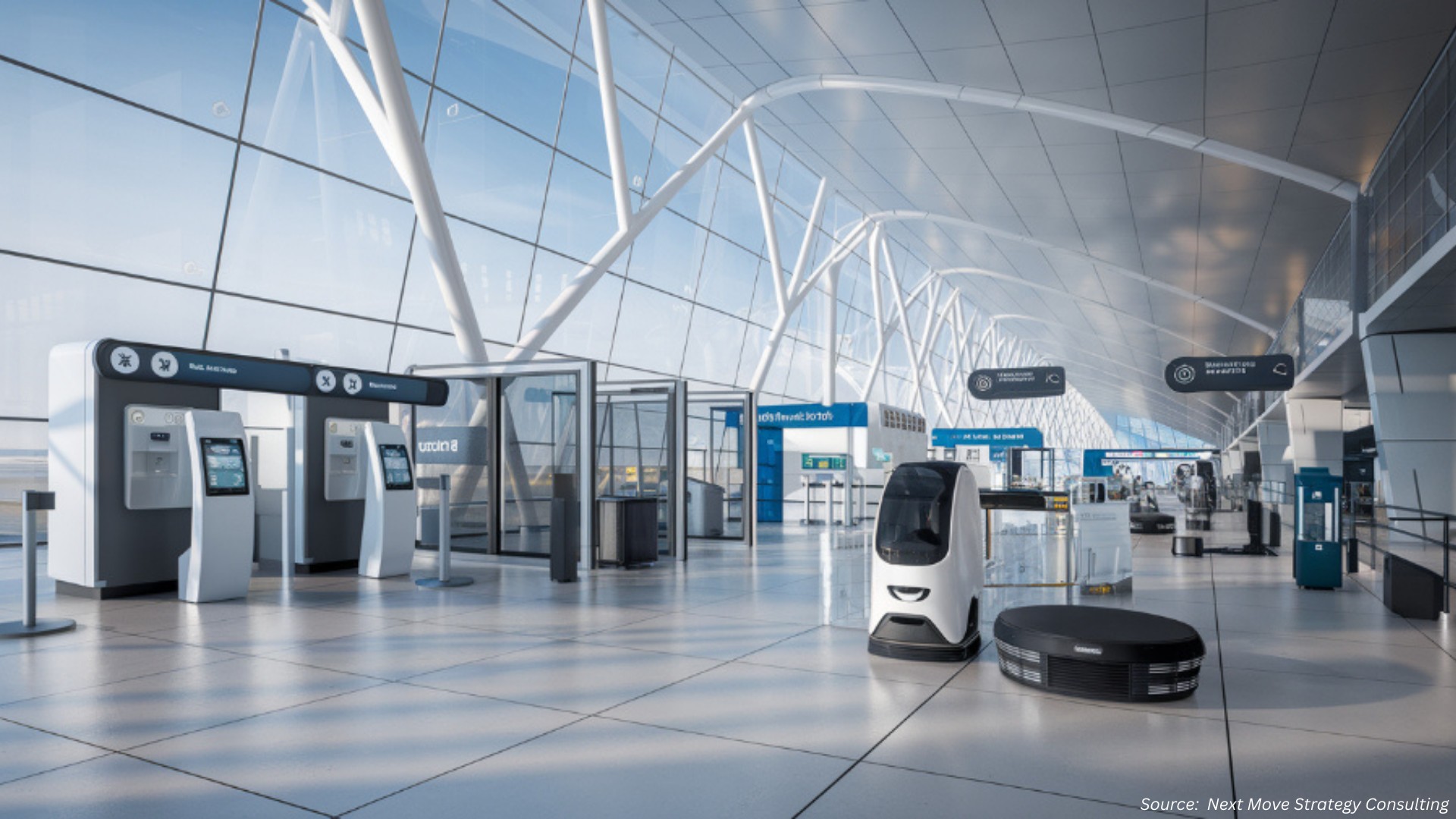Smart Airports: Revolutionizing Air Travel in 2025
Published: 2025-09-18

Airports are no longer just places to catch a flight—they are evolving into high-tech hubs designed to make travel smoother, faster, and more enjoyable. In 2025, smart airports are leading the charge with cutting-edge technology, from AI-powered corridors to biometric security systems.
What Makes an Airport "Smart"?
A smart airport uses advanced technology to streamline operations, enhance passenger experiences, and boost efficiency.
According to the report by Next Move Strategy Consulting, the Smart Airport Market is predicted to reach USD 14.91 billion by 2030, registering a CAGR of 13.1% from 2024 to 2030.
Think artificial intelligence, biometrics, and contactless systems working together to cut wait times and improve security. These airports are not just about flying; they are about creating seamless, stress-free journeys.
-
Key Features of Smart Airports:
-
Artificial intelligence for real-time decision-making
-
Biometric systems for faster security and check-in
-
Contactless technologies to reduce physical touchpoints
-
Data analytics to optimize passenger flow and resource use
-
Smart airports aim to transform the travel experience by prioritizing efficiency and convenience, as seen in groundbreaking projects across the globe in 2025.
Dubai Airport’s AI-Powered Passenger Corridor
Dubai International Airport has launched the world’s first AI-powered passenger corridor, a game-changer for air travel in 2025. This corridor uses artificial intelligence to streamline passenger processing, making check-in, security, and boarding faster than ever.
-
How It Works:
-
AI scans passenger data to verify identities instantly
-
Real-time analytics reduce bottlenecks at security checkpoints
-
Automated systems guide passengers through the airport
-
This innovation significantly reduces wait times compared to traditional methods, with the AI-powered corridor enabling immigration clearance in just a matter of seconds.
Dubai’s AI-powered corridor is a pioneering step, reducing delays and enhancing the travel experience through intelligent automation.
Ludhiana’s New International Airport: A Smart Vision
Ludhiana, India, is gearing up to launch its new international airport at Halwara in 2025, designed with smart city principles in mind. Costing Rs 5,822.12 lakh, the airport is part of a broader infrastructure push to make Ludhiana a modern, connected hub.
Smart Features:
-
Designed to align with Ludhiana’s smart city projects, which include initiatives such as 24x7 water supply and upgraded transport systems. While details of the airport’s technology-driven features are yet to be disclosed, it is expected to reflect modern, efficient infrastructure in line with the city’s smart vision.
The airport is set to open by April 2025, with commercial flight operations starting soon after. This project not only boosts connectivity but also supports Ludhiana’s goal of becoming a financial and industrial powerhouse.
Ludhiana’s smart airport is a cornerstone of the city’s transformation, blending modern infrastructure with sustainable design.
Which Key Players Are Shaping the Global Smart Airport Market?
The global smart airport market is driven by major players such as Collins Aerospace, Siemens AG, Honeywell International Inc., Raytheon Technologies Corporation, Wipro Limited, Huawei Technologies Co., IBM, Daifuku Co., Ltd., and Amadeus IT Group SA, among others. These companies are strengthening their market presence through strategic collaborations and partnerships, helping them sustain a competitive edge worldwide.
Sharjah Airport’s Growth and Smart Solutions
Sharjah Airport is making waves at ITB Berlin 2025, showcasing its plans to become a global travel and trade hub. With investments in terminal expansions and smart technologies, Sharjah is enhancing both passenger and cargo operations.
-
Key Developments:
-
Biometric security for faster passenger processing
-
Contactless check-in and boarding systems
-
Smart logistics to support Sharjah’s trade hub status
-
These advancements aim to accommodate growing passenger traffic in 2025, enhancing capacity through terminal expansions and smart technologies while maintaining a seamless travel experience. Sharjah’s focus on innovation positions it as a leader in the region’s aviation sector.
Sharjah’s smart airport initiatives are driving efficiency and connectivity, reinforcing its role as a key player in global travel.
Comparing Smart Airport Innovations
|
Feature |
Dubai |
Ludhiana |
Sharjah |
|
Primary Technology |
AI-powered corridor |
Energy-efficient systems |
Biometric and |
|
Key Benefit |
Significantly faster |
Sustainable infrastructure |
Increased capa |
|
Launch Timeline |
Operational in 2025 |
Apr-25 |
Ongoing expa |
|
Cost |
Not disclosed |
Rs 5,822.12 lakh |
Not disclosed |
This table highlights how each airport tailors smart technology to its unique needs, from AI in Dubai to sustainability in Ludhiana and biometrics in Sharjah.
Why Smart Airports Matter in 2025
Smart airports are reshaping the travel industry by addressing common pain points like long queues and inefficient processes. They also support economic growth by boosting tourism and trade. For example, Sharjah’s cargo enhancements are expected to boost trade volume in 2025, reinforcing its role as a global trade hub. Meanwhile, Ludhiana’s airport will connect India’s industrial heartland to global markets, driving economic activity.
-
Benefits for Travelers:
-
Faster check-in and security processes
-
Enhanced comfort with modern facilities
-
Reduced environmental impact through sustainable designs
-
Smart airports are not just about technology—they are about creating better experiences and supporting global connectivity.
Challenges and Considerations
While smart airports promise a bright future, challenges remain. High implementation costs, like Ludhiana’s Rs 5,822.12 lakh investment, require careful financial planning. Additionally, integrating complex systems like AI and biometrics demands robust cybersecurity to protect passenger data. Airports must also ensure technologies are user-friendly for all travelers, including those less familiar with digital systems.
Overcoming financial and technical hurdles is key to realizing the full potential of smart airports.
Next Steps for Embracing Smart Airports
To make the most of smart airport innovations, travelers and industry stakeholders can take these steps:
-
Stay Informed: Follow updates from airports like Dubai, Ludhiana, and Sharjah to understand new features and services.
-
Adopt Digital Tools: Use airport apps or biometric systems for faster check-in and boarding.
-
Provide Feedback: Share experiences with smart technologies to help airports improve.
-
Plan Ahead: Check airport websites for real-time updates on smart features to streamline your journey.
-
Support Sustainability: Choose airlines and airports prioritizing eco-friendly practices.
By embracing these technologies, travelers can enjoy a smoother, more efficient airport experience in 2025.
About the Author
 Nitrishna Sonowal is a skilled SEO Executive and Content Writer with over 3 years of experience in the digital marketing industry. With a deep understanding of the ever-evolving digital landscape, she blends analytical insights with creative storytelling to deliver impactful digital solutions. She creates content that resonates with both clients and readers alike. Outside of work, she enjoys dancing, baking, and traveling to new places.
Nitrishna Sonowal is a skilled SEO Executive and Content Writer with over 3 years of experience in the digital marketing industry. With a deep understanding of the ever-evolving digital landscape, she blends analytical insights with creative storytelling to deliver impactful digital solutions. She creates content that resonates with both clients and readers alike. Outside of work, she enjoys dancing, baking, and traveling to new places.
About the Reviewer
 Sanyukta Deb is a skilled Content Writer and Digital Marketing Team Leader, specializing in online visibility strategies and data-driven campaigns. She excels at creating audience-focused content that boosts brand presence and engagement, while also pursuing creative projects and design interests.
Sanyukta Deb is a skilled Content Writer and Digital Marketing Team Leader, specializing in online visibility strategies and data-driven campaigns. She excels at creating audience-focused content that boosts brand presence and engagement, while also pursuing creative projects and design interests.

















Add Comment